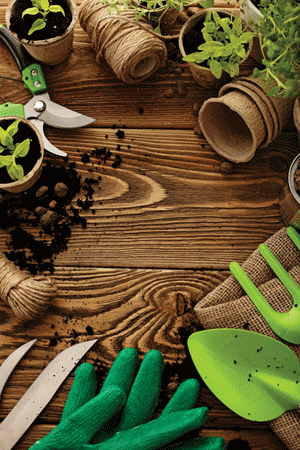
By Debbie Gardner
debbieg@thereminder.com
Nalini Benoit, assistant store manager for Sixteen Acres Garden Center in Springfield, Massachusetts, didn’t start out her life as a gardening expert. Her original passion was fashion, but a move from the UK to the U.S. for her husband’s job – and a chance job as a cashier at Sixteen Acres Garden Center 23 years ago – led her down a new career path.
“My mother was an avid gardener [in England].
As you get older and move on, you realize the environment you were brought up in, you rely on,”
she said. She credits the knowledgeable people she’s worked with over the years at the Garden Center – and conversations with some savvy customers – for expanding her expertise in garden planning and plant selection.
Here’s what she told Prime about getting your garden ready this spring:
Q: Cold spring weather has put planting and garden prep behind again this year. Are there tips gardeners can use to “catch up” the season?
“When we have to contend with a cold spring you will find that an enthusiastic gardener will not be kept at bay. We become opportunists. Here are some ideas to help you along:
“Catch up on cleaning and maintenance if the ground is not too wet or soggy. Of course, take the extra time to really plan your garden design, and look at different varieties of vegetables that you might want to try. Should you want to go ahead and actually start planting, you might find that the soil temperature is less than ideal for germination or plant growth. Plant variety dictates soil temperature requirements for germination and growth. To raise the soil temperature of garden beds, spread clear plastic, 10 ml thick, over the bed to create a greenhouse effect. You can even plant seeds, cover with the plastic, remembering to remove the plastic once germination occurs. Seedlings and young plants can be covered by individual waxed paper hot kaps, row covers or frost blankets. These can be purchased at your local Garden Center.”
Q: If you are planning for veggies – are there some crops that grow more successfully in our now-unpredictable summer weather?
“I would always try to plant a variety of certain vegetables that would be sure to give a yield in different conditions. For instance, in regards to tomatoes, you would look at different varieties and choose them so you vary the maturity time while considering their susceptibility to insect damage or fungal disease. Heirloom tomatoes are very tasty, but you have to be prepared to spray so as to combat fungus problems. There are however some heirlooms, like Black Krim, that are more resilient than others.
“A little bit of time invested in research will prove to be very valuable. Make use of a seed catalogue like Burpee Seed for a full description of the varieties. Of course the staff at Sixteen Acres – or your favorite Garden Center – can assist you but also consider browsing Pintrest, asking Google and foraging YouTube for ideas and recommendations.”
Q: If flowers are your passion, are there choices that can better withstand our increasingly dry summers?
“Again research is the key here, especially Pintrest. Check out Sixteen Acres Garden Center Boards – or the information displays at your favorite Garden Center. Perennials, such as Hyssop, Black-eye Susan, Catmint, Globe Thistle, Heliopsis and Penstemon, just to name a few, might be enough to get you started. There are also a multitude of annuals – e.g., Lantana, Dusty Miller, Celosia, Cleome, California Poppy and annual Vinca. When you plan your flower garden, consider the bloom time of each variety because a plant in flower would readily show stress at the first sign of drought.
“Remember, there are also various aids that can assist with less frequent watering. Mulching your flowerbeds will help to keep the soil moist longer. Also consider introducing something like Hydretain to the soil when planting or cultivate into existing beds. The Hydretain molecule forms a thin persistent film on root surfaces. Once treated, instead of channeling moisture away, the soil now permits absorption and dispersion of newly available water, suspending it in the soil and making it readily available to the root systems of the plants.”